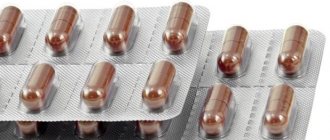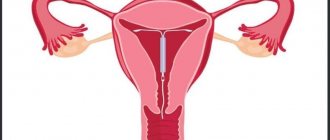In gynecological practice, when endometriosis is detected at an early stage, when the pathological process has not yet started, hormonal therapy is used to solve the problem, since the disease directly depends on the balance of these substances in the body.
Thanks to this treatment, if carried out in a timely manner, the need for surgery and possible complications after it can be avoided. There are many hormonal drugs on the pharmaceutical market, but together with this, doctors often suggest installing an intrauterine device for endometriosis.
Instructions for use of the Mirena intrauterine device
Mirena is an intrauterine therapeutic system whose main active ingredient is levonorgestrel. The intrauterine system is a conductor tube in which a hormonal elastomer is placed . Due to the permeable membrane, levonorgestrel is released gradually, reaching a therapeutic concentration in the woman’s body.
Levonorgestrel, in a quantitative content of 52 mg , has a targeted gestagenic effect. At this dose, the drug directly enters the uterine cavity, which makes it possible to achieve maximum concentrations at extremely low daily doses.
When using Mirena, there is a slight morphological change in the structure of the uterus , due to its antiproliferative effect. Levonorgestrol, being a hormonal contraceptive, promotes thickening of the mucous membrane of the cervial canal, thereby preventing fertilization.
In 50% of cases there is a decrease in ovulation.
The initial concentration of the active substance is only 20 mcg per day . Due to this amount, the systemic effect of the drug is insignificant.
Benefits of using Mirena
- Elimination of painful and heavy bleeding during menstruation. During the period of using the IUD, women note that menstruation becomes scanty or stops altogether. This occurs under the influence of the medicinal substance that Mirena secretes. This effect should be considered as positive, because by suppressing ovulation it will be possible to get rid of the growth of new foci of endometriosis and provoke atrophy of existing proliferations. By the end of the third month of using the IUD, the volume of menstrual bleeding is reduced by 88%.
- Due to a pronounced reduction in blood loss, women are able to get rid of iron deficiency anemia.
- The severity of dysmenorrhea decreases when wearing Mirena.
- While using the spiral, a woman will be able to forget about what menstrual pain is like. They will become less and less intense every month. After some time, the painful sensations will no longer bother you at all. At the same time, pain caused by enlarged foci of endometriosis will go away.
- The advantages of using the Mirena coil for the treatment of endometriosis are obvious. After all, a woman will not have to take pills every day, trying not to miss the next dose of the drug.
- The spiral has only a local effect on the body. The drug hits the target exactly, so a very small amount is required. In this regard, you do not have to worry about the high risk of developing side effects such as excess weight gain or problems with veins. Achieving high concentrations of levonorgestrel in the uterine cavity makes the endometrium resistant to estradiol.
- A woman will not have to spend money on expensive contraceptives.
- Installing the spiral is very simple and takes a few minutes.
- An overdose of the drug is excluded, since levonorgestrel is released from the capsule continuously in small portions.
Main contraindications to taking Mirena
contraindications to the use of an intrauterine therapeutic system , so before inserting the IUD, a consultation with a gynecologist is necessary. The main ones include:
- Diseases of the genitourinary system, mainly the lower sections.
- Malignant tumors, including breast cancer.
- Individual intolerance to the components of the therapeutic system.
- History of chronic liver diseases, including hepatitis A and B.
- Cervical dysplasia.
- Progressive diseases of the genital organs.
- Pregnancy and lactation. It has been proven that levonorgestrol passes into breast milk, but no teratogenic effect on the child has been detected.
Contraindications for IUD insertion
Absolute
- Acute, subacute inflammatory processes of the genital organs.
- Suspicion of genital cancer and predisposition to oncological processes.
- Uterine bleeding of unknown etiology.
- Suspicion of pregnancy.
Relative contraindications
- History of pelvic inflammation.
- Endocervicitis, colpitis.
- Hyperpolymenoria, metrorrhagia (uterine bleeding, heavy menstruation).
- Algodysmenorrhea (painful menstruation).
- Hyperplasia and polyposis of the endometrium.
- Internal and external endometriosis.
- Hypoplasia of the uterus.
- Congenital anomalies of the uterus (bicornuate, saddle-shaped)
- Deformation of the cervix.
- History of ectopic pregnancy.
- Infected abortion within the last 3 months.
How to take Mirena for endometriosis
There are no special features for placing an intrauterine device during treatment of endometriosis.
Mirena is placed in the uterine cavity for five years.
When installed correctly, the spiral retains its activity throughout the entire period. An important factor is the experience of the doctor installing the spiral. Before inserting an IUD, it is necessary to conduct a complete medical examination of the woman’s entire body, including an ultrasound examination of the pelvic organs. If, after conducting tests, the doctor has doubts about the patient’s health, it is better to exclude the installation of Mirena .
Mandatory preparatory conditions before inserting an intrauterine device are the following studies:
- taking smears for infections;
- bacterial culture from the cervical canal;
- examination for hidden chronic infections;
- transvaginal ultrasound.
These diagnostic methods will help identify contraindications and become effective in preventing complications.
After the installation of the spiral, the woman should undergo weekly examinations . If you complain of constant migraines or bleeding of unknown origin, the coil is removed.
Mirena is inserted into the uterine cavity within seven days after the start of the menstrual cycle.
Introduction of the spiral
The insertion of the IUD should be carried out by a well-trained specialist.
Necessary research before installing the system:
- general blood and urine tests;
- determining the level of human chorionic gonadotropin to exclude pregnancy;
- gynecological examination, two-hand examination;
- examination and examination of the mammary glands;
- analysis of a smear from the surface of the cervix;
- tests for infections transmitted through sexual contact;
- ultrasound examination of the uterus and its appendages;
- extended colposcopy.
The contraceptive is administered in the absence of inflammation of the genitourinary organs, satisfactory general condition, normal body temperature.
Technique for inserting the Mirena spiral
A vaginal speculum is inserted, and the cervix is treated with an antiseptic using a tampon. A conductor - a thin plastic tube - is placed into the uterine cavity through the cervical canal, and the spiral itself is passed inside it. You should carefully monitor the correct location of the “arms” of the drug in the uterus to prevent spontaneous release - expulsion of the spiral.
Is it painful to install the Mirena system?
The insertion of the IUD may be sensitive, but there is no severe pain. With increased pain sensitivity, local anesthesia of the cervix is not excluded. If the cervical canal is narrowed or there are other obstacles, it is better not to install the contraceptive “forcibly”. In this case, it is better to dilate the cervical canal under local anesthesia. The Mirena coil is thicker than usual because it contains a reservoir of hormonal agents.
After administering the product, the woman rests for half an hour. At this time, she may experience dizziness, weakness, sweating, and decreased blood pressure. If these signs persist after 30 minutes, an ultrasound examination is performed to ensure that the device is correctly positioned in the uterus. If it is not located as needed, it is removed.
During the first days after administration of the product, skin itching, urticaria and other allergic manifestations may appear. In this case, the woman should consult a doctor. Sometimes allergies can be treated with medication. In more severe cases, the coil may need to be removed.
A woman should come for a follow-up examination in a month, then in six months, and then annually.
If the instructions for use are strictly followed, no complications are observed after the introduction of the Mirena system.
After each menstruation, the patient must be taught to check the presence of IUD threads in the vagina so as not to miss the expulsion (“loss”) of the contraceptive. If such a condition is suspected, an ultrasound examination should be performed.
Side effects when taking Mirena
More than 10% of women experience uterine bleeding , oligo- and amenorrhea. In addition, there may be a disturbance in the intensity of menstrual bleeding. However, such side effects gradually disappear during the first months after the installation of MPS.
Decreased mood, lack of libido, and the appearance of acne are extremely rare. From the digestive system, bloating, nausea, and abdominal pain may occur. In 1% of cases, there is an increase in body weight.
Endometriosis and the Mirena IUD
Endometriosis is one of the gynecological diseases that is widespread among women with disrupted hormonal levels.
In this case, endometrioid cells can grow not only within the inner layer of the uterine wall, but also in any other organs. Endometrioid disease affects women in their reproductive years: from 18 to 45 years. All endometrial cells that are located outside the uterine cavity react to cyclical changes in a woman’s hormonal background and manifest themselves with menstrual-like bleeding every month. At the same time, the body reacts to internal bleeding with inflammatory reactions: the woman begins to complain of pain, swelling, and a local increase in temperature. Endometriosis can be a leading cause of infertility.
Mechanism of action of Mirena for endometriosis
The Mirena spiral is produced in Germany by the pharmaceutical company Bayer.
Mirena is a spiral that is installed in the uterine cavity. The core of the spiral is white, hormonal-elastomer, which is located in an opaque body that can regulate the release of the hormone. There is a loop at the end necessary for removing the spiral.
Mirena contains Levonorgestrel, synthesized like the female sex hormone progesterone. At the same time, the content of the active substance is significantly lower than in tablets containing a similar hormone. This is due to the fact that the effect of the drug is local.
When released, Levonorgestrel has a suppressive effect on the endometrium, which prevents it from growing. The following effects are noted:
- regulation of the menstrual cycle;
- reduction in menstrual periods;
- reduction in the volume of menstrual bleeding;
- reduction or disappearance of pain;
- with minor endometriotic lesions, a reverse development of the process or a significant reduction in the lesions is possible.
The Mirena spiral for endometriosis allows you to regulate the menstrual cycle. However, during the first three months after installation, the cycle may change:
- become longer lasting;
- bloody discharge becomes profuse;
- Intermenstrual bleeding may occur.
After 1–3 months, these effects weaken and disappear. In some cases, menstruation ends, which indicates the prevention of the spread of endometriosis due to cyclical changes in a woman’s body.
A spiral is a foreign body that is located in the uterine cavity. Because of this, an inflammatory reaction may occur in the wall of the uterus, which causes an increase in white blood cells, reduces the rate of passage of sperm and can become a breeding ground for the growth and reproduction of bacteria. In order to avoid the inflammatory process, it is necessary to install the coil with good smears and preliminary antibacterial therapy.
General information
The therapeutic coil for endometriosis has recently been used quite often. This is due to the fact that some products, for example Mirena, contain hormones, which makes it possible to stabilize the level of these substances in the body. The IUD is a topical treatment and causes fewer side effects than tablets.
What does an intrauterine device look like? Source: hormonal.ru
The IUD for the treatment of endometriosis also avoids fertilization of the egg and its attachment to the uterine wall. As is known, with such a pathology, pregnancy is undesirable, since in most cases it ends in miscarriage, which is quite dangerous for the woman’s health.
The IUD for endometriosis has a general effect on the patient’s body, resulting in the following therapeutic effects:
- The body experiences increased production of progesterone, which suppresses the production of estrogen, thereby stabilizing hormonal levels and stopping the active proliferation of endometrial cells;
- The activity of hormones is blunted, since the active components of the spiral lead to inhibition of ovulation;
- The main contraceptive effect is achieved by reducing the functions of the corpus luteum;
- The mucous membrane of the uterus becomes thinner, which leads to normalization of the volume of menstrual flow, and also eliminates bleeding outside the cycle;
- In certain situations, women pay attention to a decrease or complete absence of painful syndrome;
- The IUD for endometriosis contributes to the deterioration of blood circulation in the lining layer of the uterus, due to which the severity of symptoms is reduced;
- The composition of cervical mucus changes, and this, in turn, reduces sperm activity and increases the contraceptive effect.
The intrauterine device is an effective means of combating endometriosis. Installing the system for a long period of time acts as a major advantage, since during this time the level of hormones in the body will be controlled, and unwanted pregnancy will not occur.
Side effects of Mirena
The hormone content in the Mirena spiral is insignificant, so side effects occur relatively rarely. Possible side effects of the drug include:
- nausea;
- vomiting;
- headache;
- dizziness;
- allergic reaction in the form of local manifestations;
- depression, increased irritability;
- painful sensations in the mammary glands, their engorgement;
- changes in the nature of menstruation in the form of more abundant, prolonged and painful menstruation;
- cessation of menstruation;
- acne;
- hirsutism;
- hair loss;
- pain in the lower abdomen and back.
As a rule, all side effects disappear within the first three menstrual cycles. If the unwanted effects of the drug do not disappear on their own, the coil must be removed.
Among the undesirable effects that the spiral can cause are:
- expulsion, or loss of the spiral;
- perforation of the uterus with a spiral;
- ectopic pregnancy;
- increased risk of thrombosis, especially in the presence of venous dilated veins;
- inflammation of the uterus, or metritis.
All these conditions require immediate removal of Mirena from the uterine cavity.
Contraindications for placing Mirena
Among the contraindications to placing Mirena in the uterine cavity are:
- allergic reactions to the coil;
- pregnancy and breastfeeding;
- inflammatory processes in a woman’s body, which can provoke inflammation of the uterus;
- malignant neoplasms;
- diseases of the cervix, including inflammation, dysplasia;
- bleeding of unknown etiology;
- reduced immunity;
- congenital and acquired disorders in the structure of the uterus, including in its cavity;
- liver diseases with impaired performance.
Any introduction of an intrauterine contraceptive requires a thorough examination of the woman. After the examination and in the absence of contraindications, the doctor inserts Mirena into the uterine cavity, then monitors the woman to avoid the development of side effects.
For severe cases of endometriosis, Mirena is not used. However, the IUD is an alternative after previous hormone therapy or surgical interventions to avoid relapse of the disease.
You can rewind the attached video to 9 minutes, but in general you can watch it in full, a very interesting and educational video.
Endometriosis and the Mirena IUD
Endometriosis is one of the gynecological diseases that is widespread among women with disrupted hormonal levels.
In this case, endometrioid cells can grow not only within the inner layer of the uterine wall, but also in any other organs. Endometrioid disease affects women in their reproductive years: from 18 to 45 years. All endometrial cells that are located outside the uterine cavity react to cyclical changes in a woman’s hormonal background and manifest themselves with menstrual-like bleeding every month. At the same time, the body reacts to internal bleeding with inflammatory reactions: the woman begins to complain of pain, swelling, and a local increase in temperature. Endometriosis can be a leading cause of infertility.
Mechanism of action of Mirena for endometriosis
The Mirena spiral is produced in Germany by the pharmaceutical company Bayer.
Mirena is a spiral that is installed in the uterine cavity. The core of the spiral is white, hormonal-elastomer, which is located in an opaque body that can regulate the release of the hormone. There is a loop at the end necessary for removing the spiral.
Mirena contains Levonorgestrel, synthesized like the female sex hormone progesterone. At the same time, the content of the active substance is significantly lower than in tablets containing a similar hormone. This is due to the fact that the effect of the drug is local.
When released, Levonorgestrel has a suppressive effect on the endometrium, which prevents it from growing. The following effects are noted:
- regulation of the menstrual cycle;
- reduction in menstrual periods;
- reduction in the volume of menstrual bleeding;
- reduction or disappearance of pain;
- with minor endometriotic lesions, a reverse development of the process or a significant reduction in the lesions is possible.
The Mirena spiral for endometriosis allows you to regulate the menstrual cycle. However, during the first three months after installation, the cycle may change:
- become longer lasting;
- bloody discharge becomes profuse;
- Intermenstrual bleeding may occur.
After 1–3 months, these effects weaken and disappear. In some cases, menstruation ends, which indicates the prevention of the spread of endometriosis due to cyclical changes in a woman’s body.
A spiral is a foreign body that is located in the uterine cavity. Because of this, an inflammatory reaction may occur in the wall of the uterus, which causes an increase in white blood cells, reduces the rate of passage of sperm and can become a breeding ground for the growth and reproduction of bacteria. In order to avoid the inflammatory process, it is necessary to install the coil with good smears and preliminary antibacterial therapy.
Side effects of Mirena
The hormone content in the Mirena spiral is insignificant, so side effects occur relatively rarely. Possible side effects of the drug include:
- nausea;
- vomiting;
- headache;
- dizziness;
- allergic reaction in the form of local manifestations;
- depression, increased irritability;
- painful sensations in the mammary glands, their engorgement;
- changes in the nature of menstruation in the form of more abundant, prolonged and painful menstruation;
- cessation of menstruation;
- acne;
- hirsutism;
- hair loss;
- pain in the lower abdomen and back.
As a rule, all side effects disappear within the first three menstrual cycles. If the unwanted effects of the drug do not disappear on their own, the coil must be removed.
Among the undesirable effects that the spiral can cause are:
- expulsion, or loss of the spiral;
- perforation of the uterus with a spiral;
- ectopic pregnancy;
- increased risk of thrombosis, especially in the presence of venous dilated veins;
- inflammation of the uterus, or metritis.
All these conditions require immediate removal of Mirena from the uterine cavity.
Contraindications and side effects
After the introduction of the Mirena spiral, 22% of patients experience longer periods, but by the end of the first year of use this figure drops to 3%. Irregular menstruation occurs in 67% and 19%, respectively. During the year, complete cessation of menstruation is observed in 16%, and rare periods – in 57%.
After installing the spiral for fibroids, the following side effects are possible:
- in more than 10% of cases - headache, abdominal pain, spotting vaginal discharge, vulvovaginitis;
- in 1-10% of cases: depressed mood, migraine, nausea, acne, back pain, adnexitis, ovarian cysts, pain in the mammary glands, prolapse of the IUD;
- in less than 1% of cases: allergic reactions, itching, hair loss, increased blood pressure, uterine perforation.
Contraindications for installing Mirena with fibroids are quite varied. This device should not be used if you are pregnant or suspected of being pregnant. Therefore, before inserting an IUD, pregnancy is carefully excluded. IUDs are not administered to children under 18 years of age and women over 65.
An IUD cannot be inserted for any infectious process in the genitourinary area - chronic adnexitis, urethritis, cystitis, postpartum endometritis or cervicitis. The drug is also contraindicated for any diseases accompanied by immunodeficiency and increased susceptibility to infections. So, it should not be used in women with diabetes.
In addition, the following concomitant gynecological diseases are contraindications:
- cervical dysplasia;
- cervical or endometrial cancer;
- mammary cancer.
It is not recommended to use an IUD for fibroids of 5 cm or more, located inside the muscular wall and deforming the internal lumen of the uterus, as well as for any other anomalies in the structure of this organ.
Another contraindication is acute hepatitis or liver tumor.
It is highly undesirable to use such therapy if a woman has a migraine, an unusually severe headache, jaundice of any origin, high blood pressure, a previous stroke or heart attack, or valvular heart defects (congenital and acquired).
With subserous fibroids, bleeding during menstruation in patients is usually insignificant, so there is no point in installing the Mirena IUD.
Contraindications for placing Mirena
Among the contraindications to placing Mirena in the uterine cavity are:
- allergic reactions to the coil;
- pregnancy and breastfeeding;
- inflammatory processes in a woman’s body, which can provoke inflammation of the uterus;
- malignant neoplasms;
- diseases of the cervix, including inflammation, dysplasia;
- bleeding of unknown etiology;
- reduced immunity;
- congenital and acquired disorders in the structure of the uterus, including in its cavity;
- liver diseases with impaired performance.
Any introduction of an intrauterine contraceptive requires a thorough examination of the woman. After the examination and in the absence of contraindications, the doctor inserts Mirena into the uterine cavity, then monitors the woman to avoid the development of side effects.
For severe cases of endometriosis, Mirena is not used. However, the IUD is an alternative after previous hormone therapy or surgical interventions to avoid relapse of the disease.
You can rewind the attached video to 9 minutes, but in general you can watch it in full, a very interesting and educational video.
Endometriosis. How it occurs and why it is dangerous
With this disease, the causes of which are not completely clear, cells of the mucous layer (endometrium) penetrate deep into the uterus and spread to other organs. Pathological foci can be found in the reproductive system, bladder, kidneys, and intestines. Cases of lung damage have also been described. The disease is quite common and occurs in 10% of women of reproductive age. There are two types of endometriosis:
- Genital – affecting only the reproductive system. A separate form of it is uterine endometriosis (adenomyosis), in which endometrial cells penetrate into the uterine layers. The disease can also affect the oviducts, ovaries, and cervical tissue.
- Extragenital - affecting the intestines, bladder and other organs not related to the reproductive system.
Is this method of protection suitable for you?
style=»display:inline-block;width:300px;height:250px» data-ad-client=»ca-pub-1988978294092243″ data-ad-slot=»9486525726″>
Pros:
- high level of efficiency (98-98.5%);
- long shelf life (5-10 years);
- practicality (no additional means are required to create a contraceptive effect);
- low price of the device.
Minuses:
- the need to obtain recommendations for installing an IUD from a gynecologist;
- IUDs can only be installed by women who have given birth and do not have sexually transmitted diseases;
- the possibility of complications;
- the presence of various contraindications.
What is the Mirena spiral and how does it help with endometriosis
The coil is a plastic T-shaped device coated on top with a substance that makes it visible during an ultrasound. Below there are two threads that allow you to control the location of the spiral inside the uterus and remove it. Inside the plastic case there is a hormonal drug that is released at a dose of 15 mcg/day for 5 years.
The probability of pregnancy when using the Mirena spiral is only 0.2%. At the end of the five-year period, the contraceptive is replaced with a new one.
Despite the difficulties in getting pregnant, the disease does not guarantee a 100% chance of conception. Moreover, women with this pathology often experience complications associated with termination of pregnancy. Therefore, full-fledged contraception comes to the fore.
The installed Mirena hormonal device for endometriosis has several therapeutic and contraceptive effects:
- A contraceptive inserted into the uterine cavity reliably protects against pregnancy. The released hormones change the properties of the mucus in the cervical canal, making it more viscous. This prevents sperm from entering. In many women, ovulation is inhibited - the release of an egg from the ovary, which prevents fertilization.
- The device changes the environment of the uterine cavity. Therefore, even if fertilization occurs, the embryo will not be able to implant and survive.
- Anti-inflammatory hormones reduce inflammation and make periods less painful. In women, the general condition improves and a decrease in endometrioid lesions is observed. Therefore, it is almost impossible to find an alternative to the Mirena coil for endometriosis.
Indications for use
The Mirena intrauterine device is used in the following situations:
- pregnancy protection;
- idiopathic menorrhagia;
- prevention of hyperplastic processes of the endometrium (its excessive growth) during treatment with estrogens.
One of the main indications for use is idiopathic menorrhagia. This is a condition manifested by heavy bleeding in the absence of endometrial hyperplasia. It occurs with uterine cancer, large myomatous nodes, adenomyosis, endometritis, as well as diseases with severe blood clotting disorders (von Willebrandt disease, thrombocytopenia). After six months of use, blood loss is reduced by half, and after two years the effect is comparable to removal of the uterus.
With submucosal (submucosal) uterine fibroids, the effect is less pronounced. However, the use of Mirena can reduce the severity of pain during menstruation, as well as reduce the manifestations of iron deficiency anemia. The Mirena spiral for endometriosis has a pronounced therapeutic effect, causing atrophy of endometrioid foci.
There is barium sulfate in the T-shaped base of the coil. It is visible on X-ray examinations, such as computed tomography. Is it possible to do an MRI? Yes, there are no contraindications for magnetic resonance imaging or any other diagnostic procedures with the Mirena system installed.
Is it possible to use the Mirena coil for mastopathy? This disease is not a contraindication if breast cancer is excluded.
In what cases should Mirena not be installed for endometriosis?
- The presence of pathological lesions on the cervix, including those caused by endometriosis. First you need to cauterize or remove them, and only then install the Mirena spiral.
- Acute inflammatory and infectious processes. In this case, Mirena is placed after treatment.
- Intolerance to levonorgestrel or other materials included in the IUD.
- Suspicion of malignant neoplasms.
- The presence of fibroids in the uterine cavity, interfering with the installation and functioning of the hormonal device.
- Congenital anomalies of the uterus - saddle-shaped, bicornuate, with septa.
- Severe liver disease, liver failure.
- The Mirena intrauterine device is used with caution when endometriosis is combined with congenital heart defects, diabetes mellitus, and severe circulatory disorders.
Mirena is installed after the end of the menstrual cycle on an outpatient basis. Women during lactation can be given it without waiting for the menstrual cycle to return. However, at least 6 weeks must pass between this procedure and birth. Levonorgestrel is practically not absorbed into the blood and does not enter the child’s body, therefore it does not affect his growth and development. Tiny doses of hormones do not change the amount of breast milk produced.
Contraception can be installed immediately after an abortion. This will avoid a repeat unplanned pregnancy and reduce the risk of post-work complications.
A woman suffering from endometriosis can go to a contraception clinic in St. Petersburg to see a doctor, be examined and have the Mirena contraceptive installed. This will simultaneously solve the problem with contraception, improve your well-being and slow down the disease.
The best intrauterine devices
We present to your attention the most popular intrauterine devices. You can see how much a particular instance costs, its advantages and disadvantages.
| Name of the Navy | a brief description of | pros | Minuses | Price |
| Juno Bio | There are several options, the difference is in composition and form. | 1. Highly effective. 2. Lasts up to 7 years. 3. Used during lactation. 4. It is not felt during sex. 5. Does not affect hormonal levels. | 1. Does not protect against STIs. 2. An ectopic pregnancy may occur. 3. The product may grow into the uterus. 4. Complications are possible. | From 200 to 800 rubles. |
| Multiload | It is based on plastic and copper. Oval in shape with protrusions. | 1. 99% effective. 2. Can last up to 4 years. 3. Allowed during breastfeeding. 4. Does not change hormonal levels. | 1. After administration, dizziness and weakness are possible. 2. Painful installation. 3. Not available to everyone due to the high price. | From 1900 to 3500 rubles. |
| Nova T | Contains copper and plastic. | 1. Issued for 5 years. 2. Flexible hangers do not injure the organ and do not cause pain during installation. 3. Reliably protects against unwanted pregnancy. | 1. High cost. | From 2000 to 2500 rubles. |
| Mirena | Hormonal IUD. Every day, levonorgestrel is released into the uterus. | 1. Protects against pregnancy, prevents diseases. 2. Protects against unnecessary pregnancy by 100%. | 3. Very high cost. | From 10,000 to 12,000 rubles. |










